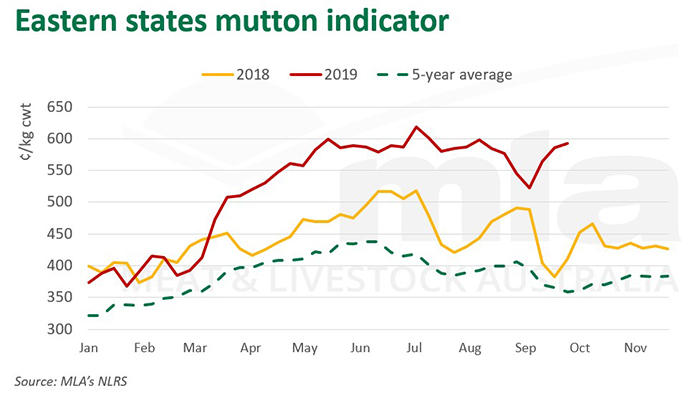Subscribe to The Weekly e-newsletter
For in-depth red meat market news, information and analysis.
Mutton prices remain strong driven by export demand
17 October 2019
Key points:
- Mutton indicator buoyed by overseas demand
- Sheep slaughter back from year ago levels
- Trade lamb prices find stability
On Tuesday, the eastern states mutton indicator was recorded at 593¢/kg carcase weight (cwt), 34% above year ago levels.
Despite falling below 600¢ at the beginning of the week, the strength of current prices is remarkable, considering the indicator is historically largely climate-driven. With the mutton market being driven almost entirely by export markets, strong demand from overseas markets has influenced the sustained price levels. This demand is unlikely to contract in the short term, as China, in particular, is increasingly sourcing alternative proteins as pork shortages from the ASF outbreak combined with a growing middle class drive demand.

For the week ending 11 October, which included the labour day public holiday, eastern states sheep slaughter totalled 134,700 head, down 13% on the same week in 2018. Sheep slaughter for 2019 has remained below 2018 levels since April, as the extreme level of destocking in the second half of 2018 has not repeated this year to the same extent. Victoria was the only state operating for 5 days last week and contributed 44% of the total sheep processed, NSW accounted for 39% of sheep slaughter, with SA processing 14%.
Turning to the lamb market, the eastern states trade lamb indicator (ESTLI) has remained remarkably stable since the middle of September, with prices remaining within a 10¢ range of 800¢/kg cwt. Prices have been far more reflective of a typical seasonal trend, similar to how the indicator tracked prior to 2018, albeit at a significant premium.
On Tuesday, restocker lambs were 157¢ above year ago levels at 861¢/kg cwt, the largest year-on-year increase of all lamb and sheep categories. Store lamb values have been well supported by southern restockers, mainly Victorian restockers, on the back of a reasonable southern wet season.
© Meat & Livestock Australia Limited, 2019


